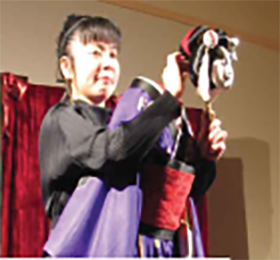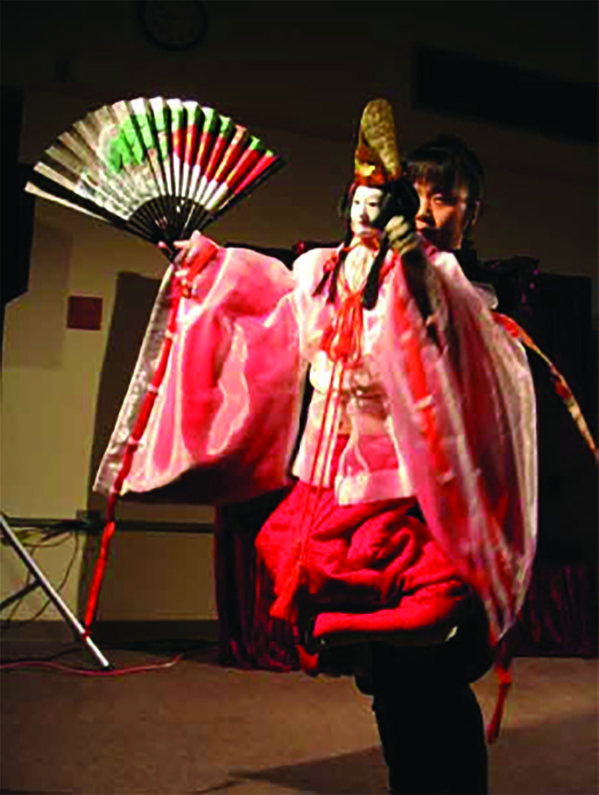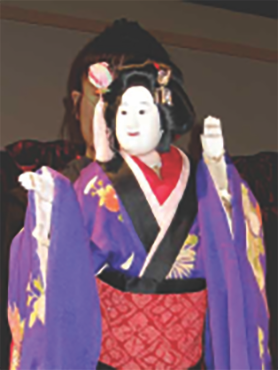Japanese Puppeteer Manami Sakamoto
Guild members who attended the holiday party in January had the great privilege of seeing a performance of Otome Bunraku by Manami Sakamoto, visiting from Japan. Bunraku is perhaps the best known of the styles of puppetry from Japan. Traditionally bunraku was the realm of men performers, and each large bunraku doll or figure was manipulated by 3 men. Otome bunraku evolved in the 1920s as special style of bunraku to be performed by women.
In addition, this style of puppetry is accomplished with various mechanical devices that are used to attach the puppet to the body of the puppeteer, so that one woman can perform one puppet figure alone, unlike the 3 to 1 puppeteers to puppet ratio of bunraku. The attachments that Manami so gracefully demonstrated to us are as follows: The puppet body (really a heavily padded kimono without an actual body) was attached to a support that held the weight of the puppet on the Manami’s shoulders, braced against her chest. On each of the puppeteers knees were supports for the “feet” of the puppet (although these were actually attached to the kimono fabric, creating the illusion of feet) and there was a silk cord running from each side of the puppeteers head (near the ear) to each side of the puppets head (also near the ear) so that when the puppeteer turned her head to the side, the puppets head, pulled by the strings, also turned in the same way. This mechanical set up left the puppeteers hands free to manipulate the hands of the puppet, which Manami did to great effect, either manipulating a hidden lever to open and close the fingers or using her own hand (underneath the puppet’s hand) to hold and manipulate a fan. For special emphasis Manami would occasionally abandon one of the puppet’s hands and use her own hand to work a delicate mechanism for opening and closing the eyes of the puppet.
The pieces Manami performed were dances set to recorded music (shamisen, the Japanese banjo, and sung narration in Japanese). The movements were slow, graceful and filled with powerful emotion, the situations being explained to us by our very capable translator. One dance was a dance of separation with a lover, where the dancer tries to hide her sorrow at the impending parting so as not to make leaving harder for her love. The second piece showed a young woman who discovers a white hair among the black and with that discovery comes a realization of impending aging. The third piece Manami performed was a rod puppet in a freer style, set to the song “Ave Maria,” where a traditional looking Japanese woman puppet soared and fluttered around the room, ecstatically interacting with audience members. Manami explained through the interpreter that the third piece was her own style that she is developing.

Photo: Manami demonstrates puppet head.
After her performance at our Guild Holiday party, Manami went on to S. California where she appeared at The Conservatory of Puppetry Arts in Pasadena on Friday, January 28th under the auspices of COPA and the LA Guild of Puppeteers. Manami is traveling the country on a cultural fellowship grant to introduce Otome Bunraku (Women’s Bunraku) to the U.S. You can visit the English language section of her website at http://www.mars.dti.ne.jp/~kimuzi/index-e.html and learn more about the art form and her work.
February Newsletter
Download your February Newsletter: Download file
Important Notice Regarding Your New Newsletter:
At the January special guild meeting the guild voted to offer both a printed and an on-line/email newsletter. Those of you who do not have email will continue to receive the newsletter by post as in the past.
Email users will have the following choices:
1. You can elect to receive your newsletter by post. To do so you must let us know that that is your wish by emailing Mary Decker at marydeck@earthlink.net or calling Michael or Valerie Nelson at 707-257-8007.
2. You can receive your newsletter via the internet. When the newsletter is ready each month, you will receive an email notice directing you how to find the new newsletter on the guild website, sfbapg.org. There, the newsletter (complete with color photos and active weblinks) will be downloadable as a pdf file, which you can read on your monitor or print out on your home printer. Also, past newsletters will be archived on the site, and the calendar will update more frequently. This month you will receive both the printed version of the newsletter as well as the email notification. Try out the online version. We hope you will like it. Remember, choosing to receive your newsletter on line saves the guild printing and postage money, saves trees, and saves lots of volunteer labor.


